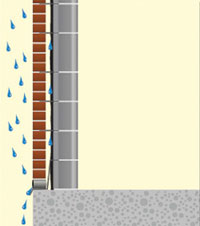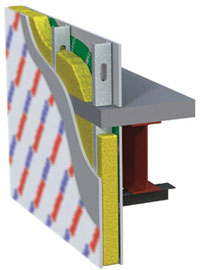Insulated Composite Backup Panels
Solid multi-wythe brick walls were the norm for centuries for exterior wall construction. This was followed by a variation of brick applied directly over poured concrete or concrete masonry. As solid construction, these walls were durable and long lasting from a structural standpoint but offered little if any thermal resistance to heat flow. Their shear mass made them an effective air barrier, but they were often porous and prone to wicking water and moisture into parts of the walls. Hence they were not always an effective barrier for water and vapor, particularly if maintenance was lacking.
 |
Masonry cavity wall construction is intended to allow water and moisture to collect and drain away between the exterior brick rain screen and the interior back up wall. Image courtesy of CENTRIA |
Masonry walls that separated the inner and outer wythes by an air cavity have become commonplace as a means to improve performance compared to solid walls. In this approach, a layer of finished brick or other masonry is located on the outermost side providing the aesthetic appearance and acting as the weathering surface or “rainscreen.” The intentional air cavity behind this outer masonry separates it from an inner or back-up layer of masonry or concrete, which is often the primary structural component as well. The cavity exists to allow moisture that may enter and get trapped in the assembly to collect and drain out through weep holes at the bottom. This drainage usually occurs on the outer face of the inner masonry wall, thus creating a drainage plane there. That inner masonry wall then becomes the basis for the barrier for air and vapor penetration between inside and outside. Thermal insulation is commonly added within the cavity, thus improving the thermal performance of the assembly, although metal brick ties often interrupt or interfere with the effectiveness of that insulation.
 |
Conventional metal framed composite walls are assembled from many separate components that are installed on either side and between metal studs. Image courtesy of CENTRIA |
Steel Framed Walls
With the advent of steel framed buildings in the late 1800s, new wall assembly options were possible for commercial, industrial and institutional buildings. Buildings became lighter in weight compared to masonry buildings and could be assembled with multiple manufactured components. This included the eventual use of steel studs for infill between structural steel members or as the structure itself for a low-rise building. This system provided great flexibility in design, less dependence on weather or season for installation, and a predictable quality from the manufactured steel products. The steel framing of course then needed to be covered or filled in to address air, water, vapor and thermal issues. That means that multiple products are added by various labor trades to include interior drywall, vapor barriers, insulation, exterior sheathing, building wrap/ air barriers, and exterior finish. The hoped for result is that the outer side of the steel framed wall is water and air tight, while the climate appropriate side is also vapor tight. In addition the thermal insulation needs to be consistently and uniformly installed and functional to achieve its full thermal resistance capability. Since all of this is done in the field under varying conditions and with varying degrees of installer capabilities, it is understandably very difficult to achieve consistent construction of a wall that will perform optimally.
Addressing Conventional Wall System Design Issues
Designing with conventional wall systems with the intention of achieving high performance in all areas, means that the weaknesses of common multi-component wall assemblies must be overcome.
Multiple PenetrationsOne of the most obvious problems is the presence of multiple penetrations from hardware and fasteners through any of the air or vapor barriers. Hundreds if not thousands of such fasteners are used to hold interior drywall and exterior sheathing in place and in the process typically puncture the barrier membranes that are otherwise so painstakingly installed. Further, masonry ties or metal panel clips are connected through the exterior sheathing and air barrier into studs to secure the finished facing or rainscreen material in place.
 |
Multiple fasteners and penetrations that need to be covered and sealed compromise the integrity of air, water, and vapor barriers in multi component conventional wall systems. Photos courtesy of CENTRIA |
Unless each of these penetrations are sealed, they are potential spots of failure that allow water, vapor or air to pass through, thus reducing the performance and efficiency of the wall or worse, causing damage to occur in the wall. This damage could include such things as direct water penetration that compromises materials like gypsum board or insulation or could lead to longer-term problems such as rusting of steel members, mold growth or loss of thermal performance from wet insulation. None of these are desired outcomes of course, but correcting them often becomes a confusing matter of blame between contractors and different subcontractors over the flaw that caused the problem, and likely citing the design as a potential source of failure as well.
Sealing Points of WeaknessOther sources of performance loss in a conventional stud frame wall include mechanical and electrical boxes that are run in the wall, thus causing a breach in the inner seals and reducing the available insulation between the studs. The actual wall framing is also interrupted by floor and roof slabs or decks similarly causing an interruption in the air, water and vapor barriers. In all of these locations, the barriers must be designed and installed to be continuous around these potential points of performance weakness. This attention to sealing is important not just for the integrity of each of these barriers, but also to reduce heat loss or gain from excessive air infiltration. The latest versions of energy codes and the recently released International Green Construction Code (IgCC) in particular, all recognize the importance of such barriers and have them mandated for inclusion in wall assemblies. They also require that they are appropriately sealed at all junctions and penetrations as described.









